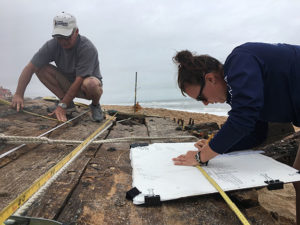The current research goal of the St. Augustine Lighthouse Archaeological Maritime Program (LAMP) is to better understand and share the founding story of the oldest port city in the United States, a story of national and international significance. Above all things, the story of our region is a story about the sea. It begins with France and Spain vying for control of the region in the late 16th century, which led to the founding of the City of St. Augustine. Our research aims to shed light on how this colonial conflict led to the founding not only of a city, but of a nation and a global society still in the making. We also study how that city has been able to sustain itself continually across the centuries and the impacts that our seaside and riverine geography had on our unique culture and heritage.
Because of the direct maritime connection of this story, LAMP focuses its research on the investigation of shipwrecks off the coast of northeast Florida, from Cape Canaveral to the St. Mary’s River. Shipwrecks represent a specific event at a specific time. They act as accidental time capsules, thereby representing a window back in time like no other piece of the past. This window shows how society and technology have changed, and also how much we share with those who lived before us and our connection to those who will come after us. Our research also involves studying archival records to gain an understanding of both official goals and outcomes as well as personal accounts.
LAMP has conducted ongoing research projects since 1999. Current projects are discussed below. Visit the Project Archive to learn more about our past research, and check out ongoing work on recovered artifacts in the Museum Conservation Lab.
LAMP’s public programs are supported in part by the State of Florida, Department of State, Division of Arts and Culture, the Florida Council on Arts and Culture, and the National Endowment for the Arts.
Anniversary Wreck

LAMP discovered the “Anniversary Wreck” in 2015 during the 450th Shipwreck Survey, so named for the 450th anniversary of the founding of St. Augustine. After conducting a remote sensing survey and identifying the site as a target of interest, our archaeologists discovered a large concentration of artifacts in a small area. Limited excavations conducted on the site thus far revealed artifacts such as stacks of iron cauldrons, large barrels, broken ceramic sherds, pewter plates, padlocks and door knobs. These artifacts suggest that the wreck is a mid- to late 18th century merchant vessel loaded with goods for use in St. Augustine. As such, further investigation of this shipwreck will aid in gaining a better understanding of colonial strategies to adapt to shifting global markets during the second half of the eighteenth century. Work will continue on the site to expose the artifact assemblage in an effort to better date and identify the nature of the wreck. Sign up for our Field School to get college credit and experience working as a maritime archaeologists on this site.
French Fleet

In 2015 LAMP conducted historical research and an archaeological survey of an area off Cape Canaveral in search of the French Fleet that was sunk by a hurricane in September 1565, after the fleet attempted to chase the Spanish from their new settlement in St. Augustine. Though the 2015 survey did not locate a 1565 French shipwreck, in 2016 a salvage group located a shipwreck off Cape Canaveral that proved to be one of Ribault’s ill-fated vessels. LAMP is working with French officials, the State of Florida, the National Park Service and others to continue to uncover this story and have partnered with French historian and philologist John de Bry to conduct archival research.
First Coast Maritime

The First Coast Maritime Archaeology Project (FCMAP) is a comprehensive program of educational outreach and archaeological research on the maritime heritage of Florida’s First Coast, with particular focus on the St. Augustine, the oldest port in the United States, and the surrounding area. Some of the sites explored between 2017 and 2019 include:
• Bond-Wheeler Site, a 19th-century coastal schooner.
• Spring Break Wreck, a late 19th-century merchant vessel that washed ashore on Ponte Vedra Beach.
• Anniversary Wreck, a mid-to-late 18th-century merchant vessel loaded with goods for use in St. Augustine.
• Dylan C. Kelch Wreck, a 19th-century flat-bottom vessel discovered in the St. Johns River near Palatka
• Canoe, a dugout canoe dating from between 1160 and 1270 CE discovered in a tributary of the Matanzas River.
The work conducted at these sites and others, both previously discovered and yet to be found, continues today to further understand the maritime history of Florida’s First Coast and its role in shaping Florida’s and the nation’s history. LAMP archaeologists share their work through outreach programs and public lectures. Check out our earlier work on FCMAP in our Project Archive file.
This project is sponsored in part by the Department of State, Division of Historical Resources and the State of Florida.

